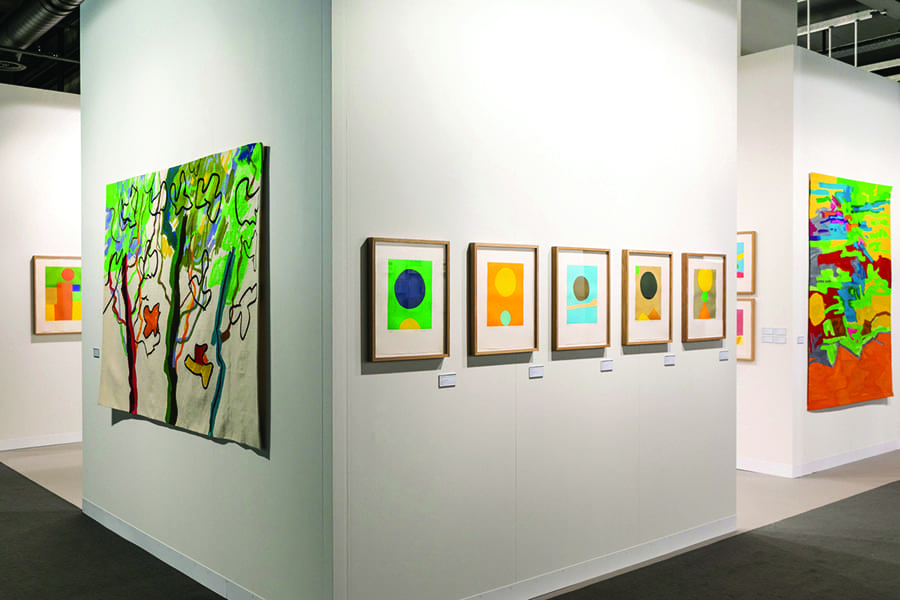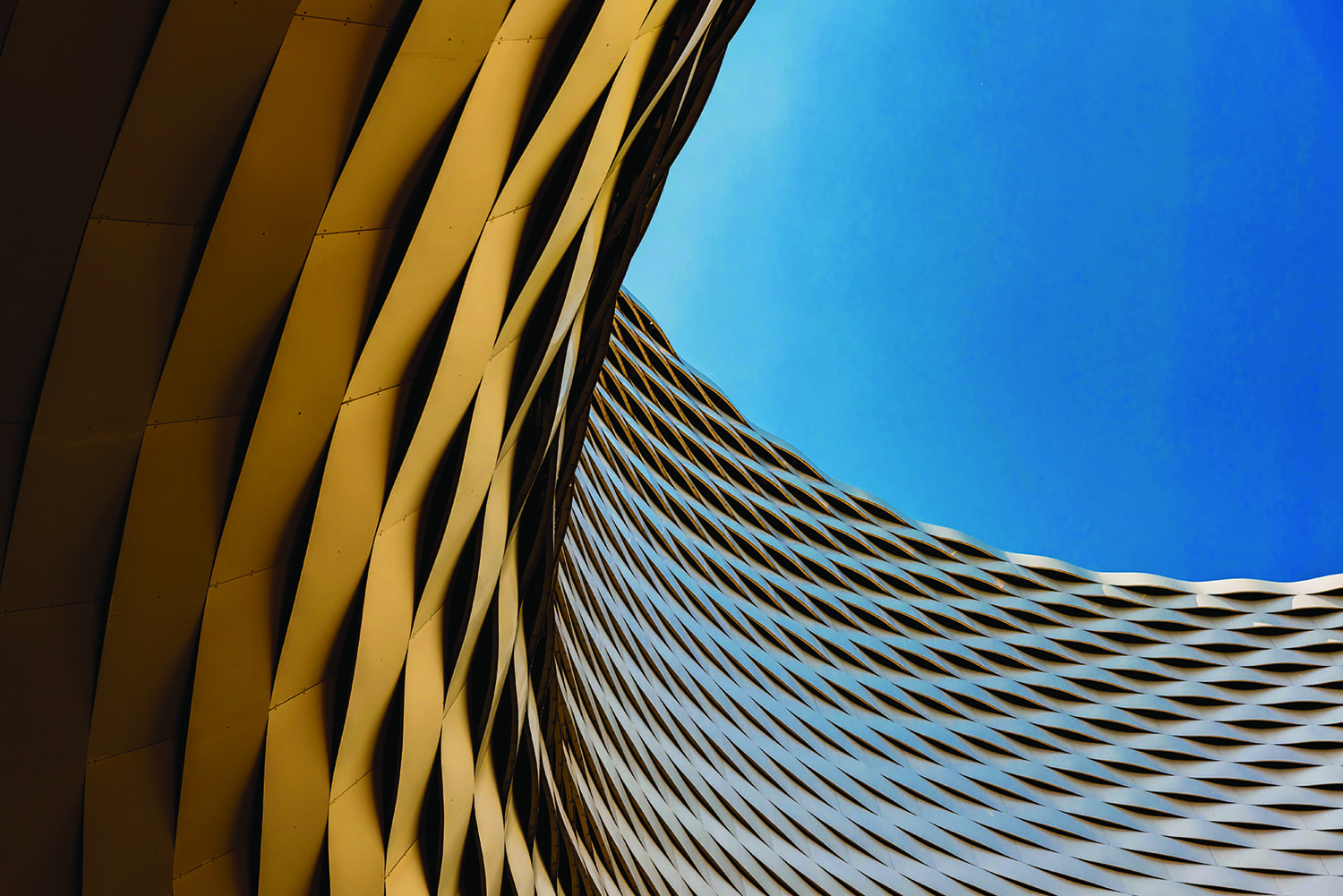
Galerie Lelong exhibition space, Art Basel 2018. (©Art Basel)
“Being part of Basel Art Fair is like having a chance encounter with a man-eating tiger; you can admire its beauty from the safety of a high branch, or you can put your head into its mouth and feel the dangerous heat. I like to do both.”
— LUBAINA HIMID
“If you are interested in collecting contemporary art on any level, you have to visit Basel,” Mary Sabbatino says, the vice president and partner of Manhattan’s prestigious Galerie Lelong & Co. She’s not talking about the city, but Art Basel, the shorthand term for three art fairs: Art Basel (Basel), Art Basel (Hong Kong) and Art Basel (Miami Beach). The nomenclature (with its parenthetical redundancy or contradiction) doesn’t make much sense without a little history. In 1970, three years after they’d attended a Cologne art fair, gallerists Trudi Bruckner, Balz Hilt and Ernst Beyeler decided to create an international fair in their home city of Basel. In the half century since, Art Basel has become a brand with a sweep extending to additional annual fairs as well as ancillary programming in partner cities and (in conjunction with the Swiss multinational investment bank UBS) a major annual economic report assessing the art market. Hong Kong and Miami Beach might be important to the art market. The same could be said for other fairs like New York’s Armory Show and London’s and New York’s Frieze. But Art Basel (Basel), typically held for a week in mid-June, is still “it”—the big cheese, the Queen Bee, the most esteemed venue for selling modern and contemporary art. A gallery or dealer with a booth at Art Basel has arrived.
Even so, the fair is high-stakes, expensive to show at and attracts an intimidatingly discriminating and monied audience. “Everyone” will be at Basel: museum directors, high-level collectors, the best galleries in the world. And they will be there in high numbers. In 2018, 290 galleries from 35 countries showed approximately 4,000 artists to an estimated 95,000 visitors.
At minimum, gallerists or dealers want to earn back their investment. With a booth costing from $10,000 to $200,000—plus additional cash outlays for travel, exorbitant hotel and food prices and shipping costs— that’s no small feat. And, in truth, no one wants “at minimum.” Hopes are always for more: a platform for the artists and, perhaps, the gallery itself. (The only bargain, Sabbatino notes, is Switzerland’s vaunted rail system, though she prefers to rent a bike. Others commute from France or Germany.)
The language around the fair—the sense that Basel is where all the monied muckymucks are—might make some uneasy. If you want to meet the 1%—or the 1% of the 1%—here they are. It’s easy to find write-ups mocking the fairs and the attendant wealth or making hay over the ridiculous prices or the nature of the wheeling and dealing. Easy, too, to have some roll-your-eyes curiosity about what fetches the highest price at any given fair. Last year, the Basel fair began with Hauser & Wirth selling Joan Mitchell’s Composition for $14 million. In Hong Kong, a William de Kooning went for $35 million. Miami Beach, in particular, has a reputation for glitzy celebrity parties. It’s all a scene in the way the art world can be a scene. (Though Nadja Sayej, author of Biennial Bitch: Adventures of an Arts Reporter, describes Switzerland as staid, “the corporate bank of art fairs.”)
And yet, Art Basel is also very much for high-powered lovers of art. An insider’s view gives you a sense of the excitement, particularly of Basel (Basel), which has the gravitas of its 50-year history behind it. “The first time you go as an art dealer, you are kind of starry eyed, as you cannot believe you have entered the hallowed halls of Art Basel as an exhibitor,” says Sabbatino. “You are aware you are part of a continuum of art and art dealers supporting quality who are in the game for the long term and the right reasons.” And those reasons are?
“To choose artists to represent and promote who have a role in history,” says Sabbatino without missing a beat.
And, indeed, Basel can transform a successful artist into an art star.
Witness the trajectory of Lubaina Himid, a pioneering member of the 1980s and 1990s British Black Arts Movement, whose work includes colorful paintings on cut out, found object and other surfaces. Her subject is Black History, erasure, domesticity and politics. Born in Zanzibar but based in Lancashire, Himid had (before Basel) a background in theatre design, a solid artistic career with impressive museum acquisitions and solo shows in the UK. Even so, she didn’t have consistent gallery representation until 2013, when London’s Hollybush Gardens took her on. Four years later, at age 63, she was the first woman of color, as well as the oldest person, to win Britain’s prestigious Turner Prize. In 2018, Hollybush Gardens directors Lisa Panting and Malin Stahl decided to devote their entire Art Basel booth to Himid’s work.
“In Basel, you’re up against the best,” says Panting, “and there’s no guarantee that you’re going to generate energy around a presentation.”
Still, Himid was a hit.
“She has a visual language that appeals to a wide range of people from young, cutting-edge curators to more mature museum audiences,” says Panting. The gallery sold everything at impressive prices. Venues in Los Angles and Vancouver acquired work, and Himid went on to international acclaim. 2019 will see a debut show at Manhattan’s New Museum, a solo show at the Frans Hals Museum in the Netherlands, a display for the Tate and a commission for Manhattan’s High Line. Himid’s own take on the fair?
“Being part of Basel Art Fair is like having a chance encounter with a maneating tiger; you can admire its beauty from the safety of a high branch, or you can put your head into its mouth and feel the dangerous heat. I like to do both.” Himid’s work will be back at Hollybush Gardens’ booth at Art Basel 2019, along with Charlotte Prodger (winner of the 2018 Turner Prize) and Andrea Büttner. But a chance to present at the fair one year is no guarantee of participation the next. Even Galerie Lelong, which has shown at every fair since 1970, has to reapply annually. This requirement, along with the fair’s consistently high standards, keeps things fresh, as does a section of the fair called “Statements” for solo projects by emerging artists.
Nineteen of the galleries at Art Basel in 2019 will be new to the fair. This year, Marc Spiegler, Art Basel’s global director, is particularly excited about showcasing an iteration of “Aggregate,” Romanian artist Alexandra Pirici’s performative environment, which will be staged in a geodesic-dome-inspired space on the plaza outside the Art Basel exhibition halls. Many have described the four-hour work as “moving,” and Spiegler (after an Argentinian version) found it “spell-binding, one of the best pieces I have seen over the last years.” This live, choreographed piece has the audience and 60 performers interact as the performers spontaneously initiate a movement from a series of previously rehearsed enactments that utilize shared cultural referents.
Kate Werble Gallery has been operating in Manhattan for 10 years, since Werble was 27. This year, she will be coming to Art Basel for the third time with a film installation and works on paper by Cauleen Smith, an interdisciplinary artist who sources from “science fiction, Afrofuturism and activism” to find ways of “understanding the new world order,” as Werble puts it. Jaqueline Martin founded Galeria Jaqueline Martin in 2011. She has exhibited at the fair in Miami Beach but not in Switzerland. In 2019, she will present a solo show of Hudinilson Urbano, Jr., a multimedia artist exploring issues of gender, politics and the body, whose career suffered under the hardships and aftermath of the Brazilian dictatorship in the mid-to-late 20th century.
What advice might a fair veteran have for Basel’s many newcomers? Panting is philosophical. She’s there to learn by watching how other galleries present themselves.
“It’s a fantastic peer opportunity in the best sense,” says Panting.
Participants say the fair is exhausting, but Sabbatino has developed a way of handling the event, which is considerably longer for exhibitors than visitors. (The fair starts on Tuesday, with installation normally taking place on the Friday before the show. Public days are Thursday through Saturday.) Art Basel is a marathon, but with the 5K of simply working in a Manhattan gallery and the longer races of other art fairs, these are miles Sabbatino has run before.
Sabbatino always spends the Monday before the fair visiting Liste, a former brewery with galleries showing the work of younger artists. Liste is a short walk from Messe Basel, the name for the exhibition halls where Art Basel takes place. With its narrow staircase, Liste— not officially part of Art Basel but a concurrent event—gets crowded, but Sabbatino goes anyway, as she always finds work by artists she wants to watch and often something to purchase for herself. Monday evening, she attends the opening of “Unlimited,” an exhibition hall for oversized pieces.
Seeing so many large-scale works in one place is “consistently exciting,” says Sabbatino. In 2018, two of the 72 pieces on display were by artists Lelong represents: Alfred Jar’s 100 Times Nguyen (multiple photographic prints of a young Vietnamese girl from a Hong Kong refugee camp) and Yoko Ono’s Mend (a performance piece and installation with table, shelving, broken ceramics, glue and scissors, all serving as metaphor for mending the world).
Tuesdays and Wednesdays at the fair are private for “VIPs,” and to get a special ticket, a collector needs to be invited by a gallery. For her own browsing, Sabbatino likes to devote one whole day to the first floor of the fair, another to the second, while trying to squeeze in a film when she can. (Panel discussions are also on offer.) Sabbatino also recommends reserving a day for Basel itself. “Parcours” is a series of public artworks throughout the city that anyone, even those without a ticket to Art Basel, can see. The Kunstmuseum Basel, with work from the old masters on, hosts an early breakfast for dealers, so they can race through the museum and then get back to the fair. And even though it can be challenging to fit in— after all, Sabbatino also has to be at her booth—she tries to get to the Schaulager for contemporary art.
No one is going to argue that Art Basel is an event for the world’s under-served, and yet, in 2019, if there is a theme to the work to be represented by the female gallerists referenced here, it is that of repair. Martin is trying to balance the effects of Urbano’s repression by making his achievements more visible. Much of the work to be presented rejects colonial, received or politically repressive notions about black men and women, gender and the body. The artists are exploring truer, sometimes more playful or simply more culturally coherent, identities. And the gallerists, in turn, are using the spotlight of the fair for the full flowering of their artists’ identities and, perhaps, destinies.
By Debra Spark

